

The Motobécane numeration series can easily prove a real source of confusion in trying to equate many of the different models to their factory model designations. There are so many, we probably couldn’t produce an article big enough to illustrate them all, but we might take a comparative snapshot of three particular period examples that will allow the reader to identify and appreciate the different features of at least some of them.
The late 1950s represented a time of big change in the way that Motobécane were engineering their base model mopeds, the last of the traditional tubular frame AV32 and AV33 models were coming to an end, to be replaced by new press-fabricated frame styles.
Motobécane had run out of room to expand at their established Pantin plant so, in 1959, started building a new state-of-the-art factory on a former beetroot field at Rouvroy. The project was assisted by Renault, who already had manufacturing experience in pressed-steel and welded frame assembly from their automotive background, and two production lines for both ‘tank-frame’ and ‘economy’ models were prepared at the same time. These new models would be particularly important for the company because, if customers didn’t take to them, the business would be in big trouble. With all the required investment to develop, engineer, and introduce the new designs, it was certainly a big gamble on success.
The plan came together in October 1960 as Motobécane presented its new range at the Paris Salon. Centre stage was taken by the artistic styling stunner Spéciale 50 model sport with telescopic forks, and supported by the fantastic new Grand Tourisme AV89 with band suspended leading-link forks, swing-arm rear suspension, pressed-steel frame, dual seat, variator drive, and all finished in spectacular ‘Chaudron’ metallic bronze paint that glistened and sparkled in the lights as if sprinkled with stardust by the Gods!
These top-of-the-range models deservedly drew the limelight, because they were obviously great machines but, equally, if not more important, though almost hidden in the background, the presentation was supported by a humble new utility model AV44, also in a new press-fabricated style, but with rigid rear frame and simple working-class single-ratio transmission. The AV44 was the first of Motobécane’s new budget range and it would be critical to sell significant volumes of these everyday models.

Apart from the change away from a traditional tubular frame assembly to pressed-steel construction, wheel size had reduced down to 23×2 (19-inch rims), so the new machines would also look a little smaller.
The AV44 De Luxe Mark 2 commenced import and listing from December 1960 and is our first featured machine because it was the first model released from this new ‘base series’. PDX 179 was registered by Ipswich CBC in 1962, and still remains a nice condition and standard-trim example, still in use at the same town it was recorded in over 50 years ago.
The model is characterised by a telescopic fork and full-width alloy hub front brake. Also, mounted in the Luxor-109, 4-inch diameter, headlamp with proper glass lens and alloy rim, this AV44 has a handsome and period Huret 60mph speedometer with silver dial and matching alloy rim. Apart from the general specification aspects, there are a few other detail differences, most noticeable of which is the rounded ‘old-style’ rear-mounted petrol tank with big alloy ‘Mobylette’ M-badge. The Prior, alloy, full-width rear hub and brake-plate are a different pattern from the later Atom hubs and, while we expectedly find this frame installed with the 6.5:1 compression, 1.4bhp ‘continuous-fin’ motor, we are surprised to find it having an external Novi HT coil hanging from the correct frame bracket! Since the bike is a known unmodified machine, the conclusion is that both internal and external HT systems might have been employed simultaneously over several years.
Starting procedures are pretty much common to almost all Mobylettes, except this older style fuel tap knob requires unscrewing to turn on. Decompress, choke trigger, kick-turn a pedal, and our beige ‘44’ fires up first time. Gentle starting is certainly the beauty of these old, low compression motors.
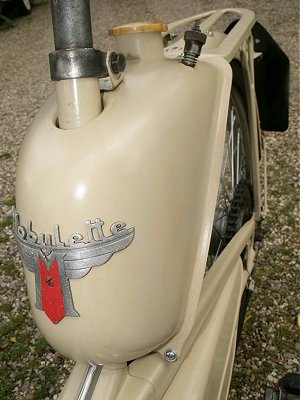
Just a couple of obligatory flicks to the choke lever before the motor beats regularly, and we’re ready to go. Pulling away is best assisted by a light boost on the pedals, while the motor pulls softly and smoothly up to towards 2044 with no more than a gentle burbling beat from the tiny silencer tucked away beneath the engine.
Around an indicated 20 (which our pace bike reads as an actual 18), combustion starts getting into a great blustery tizzy of 4-stroking, due to the small porting configuration within the cylinder. We know that cold running four-stroke issues can tend to abate as the engine warms up, so we press on around out test course. Sure enough, as the motor heats, two-stroke firing becomes progressively more regular and the speed creeps up to an indicated 25, when increasing vibrations cross an intrusive line in the sand. Our pace bike coasts alongside at this point to advise us that our actual speed in this phase was 23–2444.
Pressing on around a turn in the road allows us to pick up a reasonable tailwind along our flat, back-lane straight; so now with a hot and angry engine, tucked in a crouch, we manage to excite the Huret speedometer needle to swing up to an indicated 35—while our pace bike swoops alongside to quench our vibration-addled illusion with the news that we’ve only just peaked at an actual 27.
Sensing the Moby still has more to come on the downhill run, we dive headlong down the slope, with everything vibrating and nearly rattling to pieces, our antique moped gives its all, the speedometer bounces to indicate a dizzying 40 … while our shadowing pace bike clocks this very best effort at 28. Charging the following uphill gradient on constant full throttle, our ‘44’ faded against the incline, which was to be expected with just 1.4bhp and a lowly 6.5:1 compression ratio. Despite losing speed, the motor doggedly kept at its task, managing to complete plodding up the climb without pedal assistance, and cresting the rise at an indicated 15 (14 actual paced).
Handling was positive throughout the run; brakes were fine; a pleasant little riding bike provided you are prepared to take your time not to hurry much beyond 20 when the vibrations can become increasingly tiring.
Turning the Luxor switch through 90° on top of the headlamp shell engages the lighting set. The headlamp glows like a golden moon setting on some distant horizon, gently illuminating the night lanes with a scattered yellow shimmer that doesn’t really light much, but proves just about adequate to see by at the lowly speeds that ‘44’ achieves.
The name given to the different models on Mobylette in the UK differed from those in the French catalogues:
| Model | French | English |
|---|---|---|
| AV41 | Utilitaire | |
| AV42 | Utilitaire Dimoby | Minor |
| AV43 | Unknown | Monoluxe |
| AV44 | Standard Télescopique | Mobylette De Luxe Mark 2 |
| AV48 | Mobymatic Standard | Mobymatic Major |
The cheaper AV43 ‘Monoluxe’ model joined the listed import range from September 1961.
The AV42 ‘Minor’ model entered UK listings in 1963, and our metallic gunmetal grey test machine is a pretty exceptional example, registered CDX 184C by Ipswich authority on 15th June 1965, being run as a genuine one-owner bike for 18 years, until being laid up in dry storage for the other half of its life. Completely original, it’s a fine example of what the Brits call ‘an oily rag’, and the French fondly describe in as dans son jus (in its own juice). Many people very much appreciate a machine left like this. Having taken 36 years for the bike to gracefully age to how it appears today, there’s absolutely no need to restore the soul and character out of it, as some owners often seem pointlessly driven to do. We really can’t understand the restoration obsession to make everything look shiny and ‘new’ again—it just seems very superficial and false, like plastic surgery!
Though actually manufactured by the French Motobécane company, the frame is pinned at the headstock with aluminium ‘Mobylette’ badges, so the vehicle ‘make’ has been recorded as Mobylette.
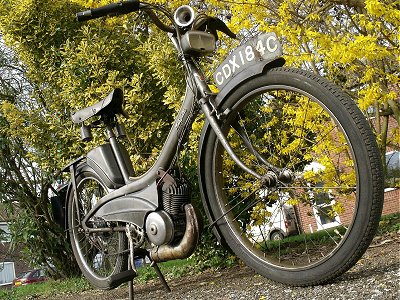
The component parts are quite interesting, since we can be absolutely positive that everything is original. The chassis 42252375 includes an external HT coil mounting location underneath the down tube, though never employed, since the original 1.7bhp (split-fin) fitted engine 5166142 is installed with a Novi internal HT ignition set. An unlikely combination of components, showing the machine was produced right on the changeover cusp of having switched to the external coil mounting frame and 1.7bhp engine, but still just using up the last of the internal coil magneto sets.
Characterised by a rigid frame with rigid fork and bicycle-style calliper front brake, the AV42 would probably be recognised by British moped riders as ‘a French Runabout’. This reference relates to the particularly popular Raleigh RM6 Runabout model of the same configuration. Assembled in Nottingham from knockdown components, the ubiquitous Runabout was a licensed derivation based upon Motobécane components. Though frames of these two comparative models by different manufacturers might appear to be the same, they are differentiated by alternative rear lug arrangements for mounting and adjusting the rear wheels. Raleigh received their base Motobécane frame elements as pressed components, and welded-in home produced rear wheel mounting lugs as they constructed the chassis. Raleigh also equipped the Runabout with its own characteristic, rear-mounted fuel tank, which extended back above the wheel.
Starting our Mobylette is a very familiar practice, except that the AV42 fuel tap is located in the top of the petrol tank behind the saddle, and operated by a rod down through the tank—this time push down for on, pull up for off. Thumb on the choke lever at left handlebar, forward decompress the throttle, kick down on the pedal, twist back the grip as the motor spins, and our engine fires up instantly, right first time!
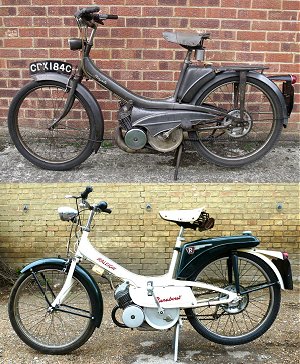
Spot the difference
AV42 & RM6
The choke lever is happy to be let off a moment after starting, a little revving to clear the tubes, and straight away the motor ticks over at such dead slow pace … you keep thinking it’s just about to falter and stop … but it doesn’t … just right on the button, even from cold!
Twisting revs on with the throttle takes up the automatic clutch, and the 7½:1 compression ratio adequately pulls the bike away from standstill without any real need to assist with the pedals. Revs drop with a slump as the secondary shoes lock in, from which the motor labours our mount up to a contented cruising around 22mph. The 22 cruising speed isn’t suggested because the motor won’t cruise any faster than that, it will, it’s just that a selection of tiring vibrations start coming in above that speed. As you go quicker, some things stop vibrating, but other items start in their place. A familiar rider could probably tell exactly what speed they were doing at any time, according to which item of the bike was buzzing at the moment!
Ignoring the vibes, the motor ran easily enough up to 26mph cruising. Best on flat, still air with rider crouched, clocked off at 31mph. The downhill run managed to raise this score to the dizzying heights of 3244, then steadily slowed in the following climb up the other side, fading down to 16mph by the time it doggedly crested the rise, maintaining its honour by accomplishing the task under its own steam without the need to pedal assist.
AV42 is most pleasant however, simply bumbling steadily along, consistently and confidently; you just know it’d keep on running like this all day, all night, just on and on…
AV’s Soubitez headlamp shell has a simple slide switch on top to operate the lights and, through the foggy plastic lens, the tiny 6-Volt, 6-Watt single filament MES screw bulb glows like a candle in a bottle. The tail is not equipped with a matching French-market rear lamp, since the continental lens would not comply with British legal requirements to illuminate the rear number plate through a clear panel. Instead, it is fitted with a Miller type 39 unit, which angrily glows like a demon’s eye, enraged by its 12-Volt, 5-Watt bulb.
This seems an odd combination of bulbs, but the headlamp fitting rather limits the 6-Volt options, so presumably the 12-Volt rear soaks up surplus wattage from the generator.
On relatively smooth tarmac, handling is nice and positive with no suspension up to reasonable speeds, but as things get faster into bumpy bends, it’s easy for a rider to appreciate the limitations.
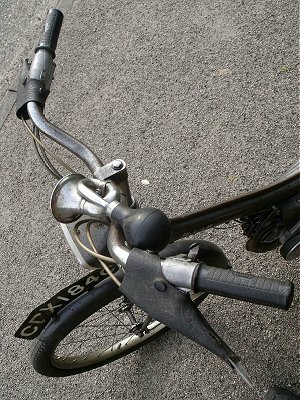
While we’re on the subject of limitations, the front brake certainly deserves a mention here. It’s really simple, everyone knows that calliper brakes are for stopping bicycles, and if you put them on a 30mph+ moped, then they’re not going to be up to the job. The brake itself even knows that, since as soon as you apply the lever the tortured brake blocks shriek in agony, all the way until you actually stop—and that can be quite a long way if you’re going to rely on this brake alone. Our conclusion was that it wasn’t actually a brake, but a very audible system warning pedestrians to get out of the way, and informing the rider they’re probably going to have a crash because the brake doesn’t work! Fortunately, the rear brake is somewhat better, and most useful stopping is performed at the back.
With decompresser cut-out, no beam–dip, and low budget bulb hooter instead of an electric horn (MoT requirements for a ‘clear and continuous note’ didn’t apply to mopeds until later, and are not retrospectively applicable since low electrical system outputs on a number of these early machines can be incapable of driving an electric horn), AV42 equipment is just about as basic as it comes. Not even a speedometer (which isn’t necessary on any vehicle below 100cc). Possibly the only ‘luxury extravagance’ on our 42 is the fitment of an archaic Wrights S.65/3 ‘tension coil sprung’ saddle, which would have been a period market accessory, but probably failed to contribute much improvement to rider comfort over the original seat. Having ridden machines with these particular Wrights saddles before, the best part of the experience is usually getting off at the destination. This seat however, was possibly in better condition than others we’ve suffered, and while the actual comfort was passable, the tension springs gave a floating, jelly-like feel … somewhat disconcerting, and rather detached the rider from ‘bonding’ with the machine.
The other notable accessory is the addition of snap-on aftermarket lever covers. Supposedly to give a warmer hand feel to metal brake levers for a rider not wearing gloves, and to prevent water ingress at the cable control heads, they’re a little scruffy and tattered now, but they’ve grown up with the bike, we still love their ancient character, and it’d seem sacrilege to remove them after all this time.
The AV42 is ultimate in pleasant simplicity, and you can’t help but love its character for nothing other than pure functionality.
Raleigh also produced its own pattern of rigid forks, front hub, mudguards and bracketry, pedal arms, handlebar sets, and fitted its own levers, Amal throttle, Dunlop Endrick pattern rims, in fact, when you look closely it can soon be appreciated that the two seemingly comparable models were produced out of almost entirely different components. Pretty much the only common parts are the engine, belt flywheel, and elements of the frame. By January 1965, Raleigh was listing its RM6 Runabout at £46–14s–6d, compared to Motor Imports posting the AV42 Minor at £51–19s–6d, and both models were competing for sales on the British market at the same time. By December 1965, both machines were being listed at exactly the same price £49–19s–6d.
Other features on the AV that distinguish it from the RM6 include the short petrol tank with pressed rack bolted to the back. The side panels are subtly different pressings, longer than Raleigh’s, who made its own for the Runabout.

The final machine in our little trio is this very nice and original AV48 Mobymatic Major. This model joined the UK import list from April 1964, and our example was registered BDX 18C by the Ipswich authority in 1965.
Like our AV42 model from the same date, this AV48 chassis 48054669 included an external HT coil mounting location underneath the down-tube, though not employed in this case, as the original 1.7bhp (split-fin) fitted engine 4742901 was fitted with a Novi internal HT ignition set.
This is another machine produced within the indeterminate changeover period of having switched to the external coil mounting frame and 1.7bhp engine, but still just using up the last of the internal coil magneto sets. Because of the unreliability of the internal coil system with age (typically cutting out when the engine gets hot), the bike has recently been converted to an external HT system.
The family resemblance to the other models is plain to see: a rigid frame, and petrol tank mounted under the seat, but the AV48 is the top-flight model of our trio, fitted with a telescopic fork set and full-width alloy hub drum front brake just like the AV44, but it also has a variator drive on the clutch set, so we might be expecting some rather different performance characteristics!
Original finish colour is the magnificent Chaudron metallic bronze as introduced at the Paris Salon in October 1960.
Since the rigid frame doesn’t ordinarily carry any mountings for the large Metalastic engine mounting bushes, which normally allow the motor to swing and effect the variator, some smaller Melatastics are neatly tucked into the cylinder head mounting bracket assembly instead.
The same system can be found on Raleigh’s equivalent models: RM9 and RM9+1.
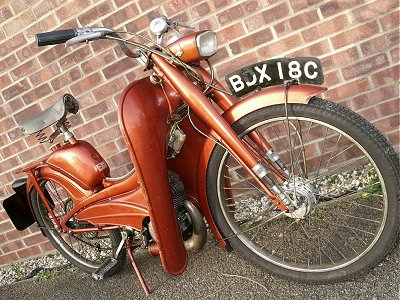
Starting AV48 is the same familiar practice, again its fuel tap is located in the top of the fuel tank, push down for on, pull up for off. Thumb on the choke lever at left handlebar, forward decompress the throttle, kick down on the pedal, twist back the grip as the motor spins, and once again our motor fires up instantly … you’ve got to admire the starting consistency of these machines! The same pattern of flicks on the choke trigger to clear the starting phase, the motor soon settles into responding to throttle, and we’re ready for another run.
Even without a pedal assisted take-off, initial acceleration is really pretty good. This is an advantage of the variator drive in low ratio, and gives an initial impression that the AV48 may be a better performer than its direct-drive cousins but, as we build up to 20+ and the motor swings back into ‘top gear’, the limitations of the 1.7bhp motor become apparent as the engine comes under load.
If we might have been thinking of AV89 ‘guts & go’, there’s a sudden reality check with the AV48, as power production is a whole 1bhp down on the happy memories of an AV89.
Best indicated on flat was 31–32mph on the 60mph Huret speedometer, but our pace vehicle reported this slightly slower at 29–30. Assisted by the mighty power of gravity and a strong belief in the theories of Isaac Newton, our Huret needle bounced and wavered somewhere between an indicated 35 and 40, while the pacer reported an actual of 36. Charging into the uphill section, our speed rapidly fell away as the four-ball variator set failed to react, so we were committed to plod up the incline in top drive ratio. The motor seemed to dig in at a steady indicated 20 on the clock, to laboriously trudge over the crest of the rise, while our pacer reported the actual at 18mph.
Out on the road, our AV48 proved only marginally better in performance than its single-speed cousins. We might have expected more, but the only effective advantage the variator provided was in initial acceleration from a standstill, and failed to offer any useful assistance on the hill climb due to its reluctance to gear down on the climb. The AV48 generally proved underpowered and over-geared in most conditions, readily dropping pace against just slight headwinds and minor inclines. On a plus side, the motor pulled consistently and smoothly, two-stroking throughout the test since it was always under load because of the high top ratio, so there was never any hint of any irritating four-stroke firing.
Our AV48 came equipped with a full leg shield set, but these were removed for purpose of the test to enable comparative results with the AV42 and 44 models, neither of which had fitted leg shields. The speedometer in this case is a 60mph Huret set.
The brakes seemed to work effectively enough, but daring to so much as touch the left-hand lever for slowing down, results in a fearsome, blood-curdling creak—perhaps the brake drum needs servicing … or perhaps this Moby is haunted!
AV48 wears a Mobylette-badged saddle, with the same sad and saggy miniature bungee straps, and the same level of discomfort as every other of these similar saddles we’ve tried in the past.
The handlebars were mounted with a novelty bicycle bell instead of a horn. Possibly more reliable, but not legal in the UK as a means of warning of approach for a motorised vehicle.
UK imports of the AV48 model stopped in October 1967.
The AV44 was de-listed in January 1968, while the AV42 ‘Minor’ ran on till December 1970, completing the type’s decade in service, but all were effectively replaced by a new range of AV40 and 50V M-series models beginning with the AV40T Majorette from January 1970.
Next—This business was recognised as the first British motor cycle manufacturer, producing its first motor-bicycle in 1896. The company has been mentioned before in a number of other articles we’ve presented over the years, but the planets have never quite come into alignment to produce an article that would do justice to this historically important marque. Our research goes back beyond the motor cycle, from the very dawn of the velocipede, and through ancient connections that became the heart of the British cycle industry. Finally, all the elements have come together to create this inspired and epic production—‘2×2’ … is that it? You’d think such a build up might have heralded a title with more impact? But it’s what the title means that’s important. There’s only been one model of British two-speed autocycle produced, and we’re running a specially tweaked version of this G2 engine against a 2-speed Villiers 1F engined motor cycle—both by the same manufacturer, and the result could be a little closer than you might think! ‘2×2’ runs Goblin against Consort in an epic feature that will very convincingly plug a hole in our features list of manufacturers.
This article appeared in the
July 2014 Iceni CAM Magazine.
[Text & photographs © 2014
M Daniels. RM6 photograph © 2012 Andy Tiernan Classics.
Period document from IceniCAM Information
Service.]
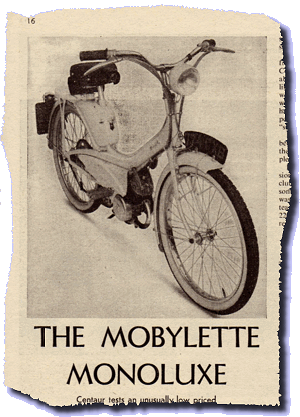
Best of Three states that the AV43 was imported to the UK from September 1961. If we refer to Glass’s Motor Cycle Check Book for 1963, this confirms, not only that AV43 number 3188164 was the first to arrive, but that imports continued in November 1962. It disappears from the listings in October 1963. Meanwhile, in May of the same year, the AV42 Minor started coming into the country—at the same time as Raleigh launched the RM5.
Now, in our comparison of French and English names for Mobylettes, you’ll see there’s no French name for the AV43. You’ll be hard-pressed to find any mention of the AV43 in any French catalogues—it lasted for less than a year and never made it into the annual brochure. The ‘43’ numbering continues in France as the CG43: a moped with cycle parts very similar to the AV43 but with a very different, roller-drive, power unit.
It’s estimated that only about 3,000 examples of the AV43 were made, whereas the other spine-frame models sold in hundreds of thousands. It was quite a bit more expensive than the AV42 considering that the only real difference between the two models was the size of the fuel tank. At this, the ‘utility’ end of the market, most customers would rather save a bit of money rather than have a larger fuel tank.
For us, the AV42 actually started the ‘Best of Three’ article off, since it was the first of the three bikes we tested, though when the article came together, the AV44 was presented first since that was the first of the three models released. The AV42 was yet another of those machines ‘bought in’ for a feature. An excellent and completely original example, genuine one-owner bike, and absolutely ideal for our road test needs. Having previously been standing in dry storage for 18 years meant it required a fair degree of servicing and light repairs through our workshops, to sympathetically return the bike to good working order but without restoring its soul out.
Over just a couple of weeks the bike was completed in early March 2011, road tested, and photoshot; then notes were drafted and dropped in the can for a future feature. With its job done and our needs completed, the AV42 became another surplus stock item on the IceniCAM conveyor belt; being particularly bought-in for a feature, it’s only destiny was to be sold on to make way for the next project. Such a pity, because it was really nice example, and we would have loved to have kept it, but it’s easy to fall in love with so many bikes, and we must keep moving on. Sadly, our AV42 was listed among the sale adverts in IceniCAM 17 and simultaneously posted on the IceniCAM website ‘Market’ ... and so, quickly, it was sold on.
An incidental chat with Hatfield-based Moby enthusiast Lindsay Neill resulted in his suggestion of a comparative Mobylette model feature, which seemed like a good idea, and his offer of an AV48 of the same period, that he would shortly expect to be completing.
We just wanted an AV44 now, to fill in the middle—Terry Smith to the rescue, with a really nice example from 1962, locally registered, and still running round its home town. We tested this bike in the middle of June 2011, and really loved its docile character and old-fashioned look.
As it happened, Lindsay’s AV48 wasn’t so shortly completed, and we had to wait until February 2013 for an opportunity to get our hands on this machine, when it turned up at the workshops for mag-set work and attention to the fuel system. Still, we figured it was worth the wait, since it meant we strangely managed to get three DX-series Ipswich registered machines together for our ‘Best of Three’ article. Comparison of features on these machines was both technically interesting and particularly surprising in establishing that internal and external type HT coil systems were being simultaneously employed on various machines for several years, and there really doesn’t appear to have been any decisive switch over from one type of ignition system to the other. AV44 owner, Terry Smith of our own Suffolk Section EACC, so much wanted to see the article produced that he made a donation to sponsor the feature, however this probably proved a longer wait than expected due to the delay in getting the AV48, then being locked into the World series sequence until we might ‘return to France’ again at the appropriate moment.
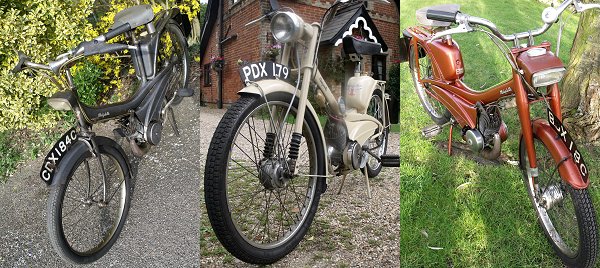
The three Mobylettes—in numerical order